New Grocery Store Located Among Walkable Neighborhoods Not Designed For Pedestrian Customers/Employees
A new grocery store will open soon on the near south side, between Soulard to the east, Lafayette Square to the west, and The Georgian/King Louis Square to the north, Lasalle Park. The I-55/I-44 highway interchange is to the south. Technically this is located in the Peabody Darst Webbe neighborhood, partly named after the former public housing project that were located where King Louis Square was built years ago.
Fields Foods is our vision come to life. A full-service grocery store rooted in the heart of historic Lafayette Square near downtown St. Louis. The Lafayette Square area is one of St. Louis’ oldest neighborhoods with historical stores, parks and homes. It’s truly one-of-a-kind, and that’s why it’s the perfect fit for our store.
Our team of friendly, dedicated, knowledgeable foodies guides our customers through a vast arrangement of local, healthy, delicious foods that will inspire your inner gourmet. You will walk through lush fields sampling vine-ripened fruits and vegetables. Stroll down urban streetscapes and visit the local butcher and baker. Head down to the docks to our seafood shack and enjoy what truly fresh from the sea means. And if you’re not in the mood to cook tonight, that’s okay. Stop by our prepared food section and pick up a slice of brick oven pizza, a toasty panini, salads and so much more. Need a bit more than a slice of pizza? We have a chef on staff creating restaurant quality dinners for carry out. A Sushi bar and a Wine and Beer cellar stocked with vintages from across the globe and local craft beers completes your experience.
Many area residents, tired of having to drive to the grocery store, welcome a neighborhood store they can walk to.
“Can’t wait to have a grocery store within walking distance. Actually I can see the store from my 3rd floor window.”— Jean C. commented on a Facebook picture.
A market here was proposed in early 2007:
Koman recently partnered with Chris Goodson of Gilded Age on plans for an $80 million mixed-use development just east of the Lafayette Square neighborhood and just south of downtown. Goodson’s Georgian Square development includes plans for a Walgreens, grocery store and coffee shop. Goodson has helped transform Lafayette Square in recent years. In 1999 he helped spearhead the creation of an $8.5 million tax increment financing district in Lafayette Square. Through Gilded Age, a development company Goodson founded with partner Trace Shaughnessy, he has developed more than $125 million in real estate projects since 1996. He also is president of the St. Louis Board of Police Commissioners. (St. Louis Business Journal)
Immediately south of downtown, another grocery store is under development. St. Louis-based Gilded Age plans to break ground on a Walgreens across the street from its Georgian Condominiums this August. Next to the Walgreens, a City Market grocery store, a unit of SuperValu, will open in the summer or fall of 2008, said Gilded Age principal Chris Goodson. (St. Louis Business Journal)
In March 2008 things were still moving forward:
The SLDC already has approved forgivable loans for two other projects to receive funding from the pool of excess revenue: Gilded Age and Koman Properties’ planned $30 million first phase of its Georgian Square retail development, across from Gilded Age’s Georgian condominium project, will receive $300,000. The developers have signed an agreement with Walgreens to locate on the site, said Gilded Age principal Chris Goodson. A City Market grocery store, a division of Supervalu, and a Starbucks are also planned for the development. “We’re moving forward with the Walgreens, that will be built first,” Goodson said. (St. Louis Business Journal)
The Walgreens opened in 2009. Several other attempts were made to get a grocery store here, but each fell through:
When Gilded Age announced plans for a grocery in 2007, it was with Minneapolis-based Supervalu, a project that never materialized. Other pending deals with Phoenix-based grocery chain Sunflower Farmers Market and local operator Sappington Farmers’ Market also failed to move forward. (stltoday.com)
I’m very glad to see the store nearing completion. It’ll provide needed jobs, though jobs may be lost elsewhere as people change where they buy groceries. Sadly, it doesn’t appear any consideration to the many who will arrive daily on foot, some pushing strollers, and even the occasional wheelchair user. Let’s start in the adjacent Bohemian Hill to the east.
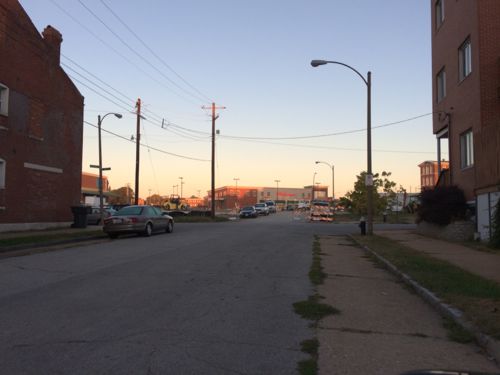
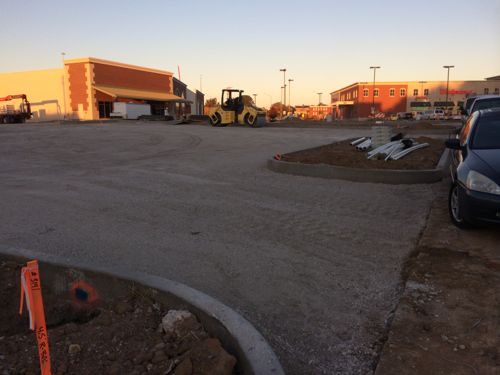
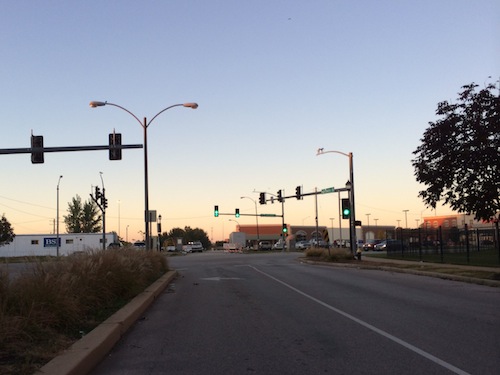
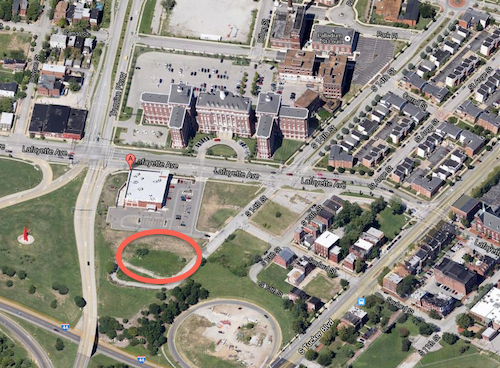
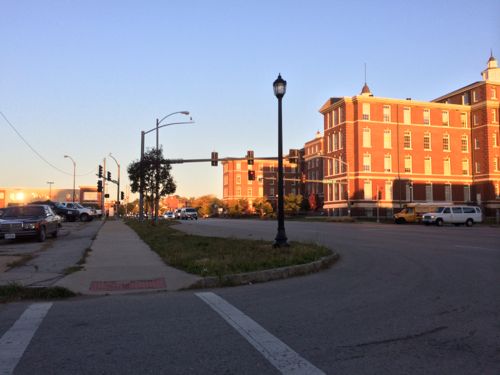
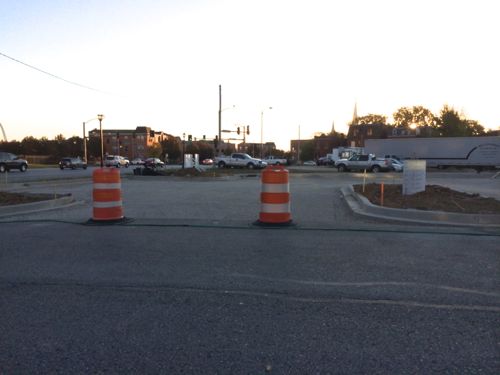
I understand most customers and many employees will drive to this new store. I also know many will opt to walk here from home, Walgreens, nearby bus stop, etc. How many isn’t know, but if we do a pedestrian count later it’ll surprise you just how many do walk, or bike. Had the civil engineers, architects, & developers actually planned a welcoming sidewalk approach the numbers would be higher. From press releases and articles it’s clear they’re not targeting local residents, “Goodson and Randol also hope the store’s proximity to major highways will attract customers entering or leaving downtown St. Louis.” (Sauce)
Clearly the city has been working with the developers for six years on this project, there was time to figure out how residents of his own project across the street can walk to his new grocery store. The city failed big time by not requiring good pedestrian access.
Hopefully, somehow, I’ll be proven wrong when the grocery store opens January 4th.
— Steve Patterson
Opening January 4th?? Is there anything there today besides a vacant lot? They’re going to build the building in 2 months?? Don’t projects like this usually take at least 6 months to build? I need to get down there again to see if there’s more than some scratching around the ground. And what about the derelict buildings next to this site? Are they ever going to do something with those? Those highway travelers are less likely to stop if they think they are driving into a slum.
Huh? My pictures show the building under construction, they’ve been building it much of this year. The area is very nice, hardly what anyone would call a slum.
If you think Lafayette Square is a slum then you need to leave this city.
Not talking about Lafayette Square. Talking about the buildings on the east side of the store site, fronting along 12th/Tucker.
It’s a great neighborhood, except for the giant freeway interchange which cuts the pedestrian market for this store in half.
Like you say, it’s still early and most of the concrete flatwork is far from being completed. Unless you’ve seen the final plans, jumping to conclusions may be a bit premature. That said, there is a difference between complying with the minimum ADA requirements and creating either a welcoming or a truly functional pedestrian environment on a site that features a set-back supermarket and a typical suburban-style surface parking lot. The good news is that both 14th and Truman are signalized intersections, so getting across Lafayette won’t be any worse than any other signalized intersection in the city. The bad news is that the old hospital’s front door is halfway in between, so a lot of people may end up jaywalking.
In the universe of pedestrians, there are two groups, the able-bodied and those with disabilities. For the able-bodied, sidewalks and parking lots are pretty much interchangeable – we take the straightest path, not always the designated path. While we appreciate and value the public sidewalk (that parallels the public street), we place much less value on a private sidewalk that is perpendicular to public sidewalk IF we can take/make a diagonal “shortcut” through a parking lot or over the grass. For people with disabilities, who require a continuous, flat, hard surface, obviously a continuous, direct path is much more important. I get that, the nuance is getting the developer to see the value of “better” over “minimum requirements”.
The other half of the equation is in how people (will?) shop for groceries here. Will they be making multiple small purchases, coming by every few days? Or, will they be making fewer, larger purchases, once or twice a month? This will inform the mix of drivers versus pedestrians, even among the customers who live nearby. If you can easily carry your smaller purchase home, walking is always more of an option than if you’re trying to move 3 weeks’ worth of groceries. Sure, anything is “possible”, but there’s also a reason why Sam’s Club and Costco always have large parking lots!
It appears the concrete work is now complete, prep work for asphalt has started. If any big box retailer wanted to build a typical suburban prototype nestled among walkable neighborhoods I think people would object. They’re being led to believe this is a friendly neighborhood market they can walk to.
Yes, the able bodied can walk across parking lots, over curbs, through grass — but that doesn’t mean we must allow new construction to be built that way.
Agree – my point is how do we move beyond the ADA minimum? The challenge is basically one of geometry – most parking lots are a grid while most pedestrians want to cross them diagonally. The Maplewood Walmart has a compliant sidewalk – http://goo.gl/maps/Tj82s – I even try to park next to it on the rare occasion that I shop there. But if I lived nearby, to the north or the south, and was walking in from Hanley Road, I’d want to have a direct connection from the corner of the property, not the center point. In an urban context, with the building next to the sidewalk (and hopefully, the front door, as well), it’s a non-issue – see the Walgreens on the same site. But in the typical suburban context, 99% of the time, the required pedestrian access either follows the perimeter or is perpendicular to the public sidewalk. Pedestrians don’t want to take the two sides of the triangle, they want to take the hypotenuse! And I get that it “should” happen, how do we make it actually happen, much more frequently? Who needs to be reeducated? Who needs to have theirs eyes opened? Civil engineers? Architects? City Planners? Code Officials? Developers? Tenants? Owners? All of the above?! Pointing out that it will probably suck, now, at this point in the construction process, will NOT make things better!
just put the parking lot in the back, solves all problems, how hard is that?
Not really – in most case, the “front” door follows the parking, so you end up with the “back” of the building up against the public sidewalk. (And even if you put in windows, they usually end up getting covered over.) You’re fighting the most basic form of democracy – most people drive to the grocery store so most grocery stores provide free parking and orient their main entrances toward where most of their customers come from (that damn parking lot!). Until you change basic human nature (taking the easy way out), you’re not going to eliminate the parking lot – it is that hard!
Placing new buildings up to the sidewalk, with parking to the side/back, allows pedestrians to stay on the sidewalk to reach the entry.
Side, yes; back, no. I’ll repeat – most customers drive. If you provide parking, they will use it and they will expect the front door to be adjacent to the parking that you’re providing. If you force them to walk around the building, to find the traditional, urban front door, they will either complain or not shop there, at all. No, it’s not “fair” that pedestrians are a definite minority, but it should be no surprise that retailers will / do focus their efforts on providing the greatest convenience to the greatest number of their customers! They’re in business to make money. If 90% drive and 10% walk/bike/roll (and if drivers spend more, per person, because they have the ability to carry more stuff home with them), then it has nothing to do with disrespecting pedestrians and/or the “traditional” built environment, it has all to do with making as much money as possible!
I’ll remind you of the Illinois grocery chain called County Market, they now have a few stores that have two entrances.
Most Dierberg’s have two entrances – does that count?
Many grocery stores have two entries. Which is why I think it’s feasible to have one oriented to the street and one to parking.
if it was only about making money we wouldn’t have something called ZONING!
And that’s why we do have zoning. The “problem” (if there is one) is that zoning rarely requires both that parking be located on the side or back of a structure while, at the same time, requiring that the primary entrance / “front” door be located away from the parking lot / on the “front” of the structure, directly connecting to the street and public sidewalk. Could we require both? Absolutely, just like we could require hitching posts or thatched roofs. Could we require that every retailer provide two separate entrances, one for drivers and one for pedestrians? Again, yes. The two big problems, both directly related to the Law of Unintended Consequences, is that most retailers don’t want to do this, for very valid security reasons. They will either choose not to locate in any zoning district with said requirements (unless they get an exemption) or they will simply neglect to unlock the door(s) after the first few weeks of operation (likely in direct violation of exit requirements). The other big challenge, with a side parking / side entrance configuration, is that it ends up creating / encouraging the “missing tooth” phenomenon, where the traditional urban streetscape ends up alternating structures and parking lots.. Whether that’s better than all parking lots, or not, is open to discussion, but it ain’t the traditional, urban streetscape, either.
I plan on shopping here pretty often (if it is as nice as promised) and vincent’s market will loose some business from me. Vincent’s has a great butcher, but the deli and cheese selections are pretty bad, and this places promises to be higher end, hopefully some decent bread in the neighborhood too (nothing wrong with fazio’s at vincent’s for the most part, but the baguette is atrocious). You cherry picked that comment from the owner about the highways, I am sure they are planning on catering to the neighborhood as well (who wants higher end goods, someone from laf sq, or someone driving home to oakville from downtown? you tell me). The fact that there will be a full service bar inside the store sounds pretty cool as well (and hopefully will promote pedestrian use, but I doubt it). I plan on being there jan 4 @ seven am, and if I have issues walking there they will hear about it day one. On a side note, the local media has been covering this as bringing food to a food desert. A food desert? spare me, this location is 5 blocks from soulard market. Hey local media, get out of west county or buy a map, or both!
People always say they want pedestrian friendly buildings and the “oh, I get to walk” giddiness. Until they shop. They’ll end up driving, the walking is for everyone else. It is human nature to take the easy way. And if you think I’m mistaking, then ask them to reduce their parking spots by 3/4…after all everyone is going to be walking so they won’t be needed.
my recollection is that back in the “old days”–the 1940s and 1950s–many people had their
groceries delivered from a nearby neighborhood grocery store. If you did walk you obviously
could not carry many groceries yourself
And your point is? That we need to revert to small neighborhood grocers and give up supermarkets? That grocery stores need to offer delivery services for those who choose to or cannot drive? You’re right – that was the “old days”, nearly a century ago. Not everyone had cars, especially many stay-at-home moms, aka domestic goddesses. And that’s part of my argument – retail architecture reflects current consumer demands, not some historic fantasy . . . .
Both Schnucks & Dierbergs now offer home delivery.
I thought I was making the same point you are making: that the days of the walkable
grocery store are basically gone in that it relied on the fact that groceries were de-
livered (and, to answer steve, I beleive at no extra cost) I do not think it is possible
at all to return to the days of the neighborhood grocery store, unless we want much
higher prices, and less selection, and always have someone at home to wait for
the delivery boy
How does home delivery even play into pedestrian traffic concerns for any retail store? Not only does it take pedestrians away from the store, it adds to the costs of goods and pollution (depending on type of delivery). Dempster is right…the days of walkable retail are basically gone. Be it Schnucks, Lowes, Best Buy, any thing that weighs more than a few pounds or bigger than one or two loaves of bread and people aren’t going to walk, they are going to drive. And even scootering is considered driving.
Home delivery cuts down on cost and pollution. For every X (a number) customers, instead of having X trips from home to store and back, you have 1 trip which stops at X houses. Much more efficient if the store plans it well (and they have a strong financial incentive to do so). It’s like public transportation for goods – many destinations on one trip.
Huh?! Home delivery will never cost less! To deliver anything from a brick-and-mortar store (as compared to a distribution warehouse) requires that a paid employee pick the items off the shelves and package them, and requires another paid employee to deliver the goods to the customer’s home, using a company vehicle consuming company-paid fuel. In contrast, in the world of self-service, we pick the items off the shelves ourselves (for free, and we’re responsible for any mistakes), we may or may not scan and package the items, and then we drive them home (for free). As for pollution, a lot boils down to how people shop – online versus in the store, every few days versus every two or three weeks, decisively (one or two stores) versus indecisively (many stores), many small deliveries versus one large one. In theory, yes, home delivery might reduce pollution; in reality, in our world of multiple options, any reduction is likely negligible or hypothetical . . . .
I don’t know why stores offer delivery if, as you say, it’s so much less profitable (the store has to package and pay for gas, rather than you).
In my experiences, deliveries are usually for very large orders, while a significant of store visitors make small frequent purchases. Not the reverse.
Most traditional, brick-and-mortar stores (no longer) offer delivery, but many chain stores run parallel websites offering an online presence and, many times, a larger selection. The difference is that they’re shipping from a central warehouse and using UPS or FedEx, not a local delivery service or their own resources, and their online side doesn’t have multiple retail locations. It’s basically apples and oranges, to use a bad analogy, even though they operate under the same name. There’s also a difference between perishable items (groceries) and hard goods (clothing, electronics). The former we consume every day and are harder to ship, especially from a central location, while the latter are purchased less frequently and are far easier to ship (they won’t spoil in transit).
Milk used to be delivered to our door two days a week, back when mom was home and could bring it in, and many times didn’t have her own car. Today, mom probably works, has a car and finds it easier to pick up a gallon on the way home than to have it sitting in a box outside the back door all day. Since the brick-and-mortar store doesn’t need to offer delivery, they can charge a lower price than the home-delivery dairy, and many shoppers would rather save the per unit price than pay for delivery.
Not sure what you base this on. Schnucks Express is a subdmain of the main Schnucks website. Delivery is done locally, not via USPS/UPS, they even answer a question about tipping the delivery person: “Tipping is not required and certainly not expected, but is always appreciated. If you choose to tip the delivery person, the amount is your decision and should be in cash only.”
Schnuck’s charges a significant fee for delivery ($14 – $17) and a lower one for in-store pick-up ($6.95) – it’s not free! Yes, you can get stuff delivered from Schnuck’s (and from pretty much any other store) IF you’re willing to pay. That’s not the point, the point is that many stores USED TO offer free home delivery for their customers, now it’s a rarity, and if it is offered, it’s either through their national website or by charging a fee / surcharge. The availability of free home delivery would make it more attractive to some (many?) people to walk to the store to do their shopping. Paying $14 or $17 does nothing to encourage pedestrians, providing “free” parking does everything to encourage people to drive!